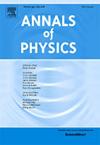普朗克子是量子虫洞的入口和时空的全息起源
IF 3
3区 物理与天体物理
Q2 PHYSICS, MULTIDISCIPLINARY
引用次数: 0
摘要
我们认为,普朗克尺度波动“普朗克子”实现了一个不可穿越的爱因斯坦-罗森桥网络,并充当全息装置。将浮游生物建模为极面(RT)上的虫洞口,将时空连通性与纠缠直接联系起来。利用Ryu-Takayanagi框架,我们推导了一个支配普朗克系综热力学的纠缠熵。所得配分函数表现出与全息标度一致的高温对数熵,而在低温下,网络冻结成稀疏的残余相。特征温度Tc(由普朗克子间隙设定)将这些状态分开;在非相互作用的边模式描述中,这标志着交叉(一旦包括相互作用/配对,就成为真正的相变)。在虫洞喉中嵌入最小长度会产生量子校正的贝肯斯坦熵,其中面积项由边缘模式贡献补充,从而将虫洞几何与量子信息流联系起来,并提出时空和黑洞微观结构的全息起源。本文章由计算机程序翻译,如有差异,请以英文原文为准。
Planckeons as mouths of quantum wormholes and holographic origin of spacetime
We argue that Planck-scale fluctuations “planckeons” realize a network of non-traversable Einstein–Rosen bridges and act as holographic devices. Modeling planckeons as wormhole mouths on extremal (RT) surfaces ties spacetime connectivity directly to entanglement. Using the Ryu–Takayanagi framework, we derive an entanglement entropy that governs the thermodynamics of the planckeon ensemble. The resulting partition function exhibits a high-temperature logarithmic entropy consistent with holographic scaling, while at low temperature the network freezes into a sparse remnant-like phase. A characteristic temperature (set by the planckeon gap) separates these regimes; in the noninteracting edge-mode description this marks a crossover (and becomes a genuine phase transition once interactions/pairing are included). Embedding a minimal length in the wormhole throat yields a quantum-corrected Bekenstein entropy in which the area term is supplemented by edge-mode contributions, thereby linking wormhole geometry with quantum-information flow and suggesting a holographic origin of spacetime and black-hole microstructure.
求助全文
通过发布文献求助,成功后即可免费获取论文全文。
去求助
来源期刊

Annals of Physics
物理-物理:综合
CiteScore
5.30
自引率
3.30%
发文量
211
审稿时长
47 days
期刊介绍:
Annals of Physics presents original work in all areas of basic theoretic physics research. Ideas are developed and fully explored, and thorough treatment is given to first principles and ultimate applications. Annals of Physics emphasizes clarity and intelligibility in the articles it publishes, thus making them as accessible as possible. Readers familiar with recent developments in the field are provided with sufficient detail and background to follow the arguments and understand their significance.
The Editors of the journal cover all fields of theoretical physics. Articles published in the journal are typically longer than 20 pages.
 求助内容:
求助内容: 应助结果提醒方式:
应助结果提醒方式:


